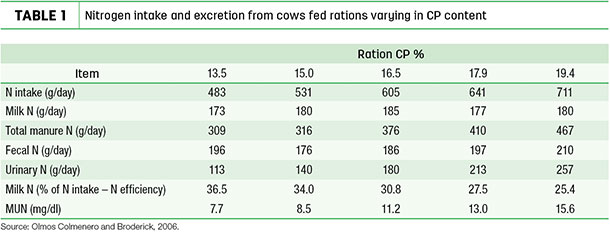Nitrogen (N) utilization is becoming a central component in ration balancing as dairy producers try to maximize milk protein yields, decrease feed costs and conform to environmental standards. Previously, our nutritional models and research in dairy cows dictated that we feed higher crude protein (CP) levels to achieve optimal performance.
With our improved understanding of N efficiency and the introduction of balancing for metabolizable protein and amino acids, we have been able to improve N efficiency in dairy cows.
Most N is provided in diets in the form of proteins and amino acids. Nitrogen is a key component of all amino acids, which are the building blocks of proteins. There are also forms of non-protein nitrogen (NPN) which can be fed to dairy cows, with urea being an example of an NPN source.
As nutritional knowledge has advanced, we have gone from balancing dairy diets for CP to balancing for rumen-degradable and rumen-undegradable protein (bypass protein) to now balancing diets for metabolizable protein. Metabolizable protein consists primarily of microbial protein produced in the rumen and rumen-undegradable protein.
We also balance for some individual metabolizable amino acids. Our increased understanding of N metabolism in the dairy cow is leading to improvements in N efficiency.
We calculate N efficiency of a lactating cow as the grams of N secreted in milk as a percent of the grams of N fed in the diet. In lactating dairy cows, N efficiency on a herd-wise basis varies from as low as 20 percent up to 36 percent, with some higher-producing groups of cows on some dairies approaching 40 percent N efficiency.
Wisconsin research from 2006, shown in Table 1 on page 15, is one of the best examples of how dietary CP and N efficiency interrelate in dairy rations.
 As ration CP percent is reduced, N intake decreases; total manure N decreases; urinary N decreases; however, fecal N doesn’t change.
As ration CP percent is reduced, N intake decreases; total manure N decreases; urinary N decreases; however, fecal N doesn’t change.
So when we increase dietary CP, the excess N is excreted via the urine, which leads to environmental concerns. You can also see in this example that N efficiency improves as the ration CP is reduced, and milk urea nitrogen is reduced as well.
These results raise a couple of key questions: Why is there such a wide variation in N efficiency in U.S. dairy herds, and why don’t we just lower dietary CP levels to 13.5 percent as was done in the Wisconsin research?
So what are some of the reasons for the wide variation in N efficiency in U.S. dairy herds?
- Production levels (milk and milk components) can vary widely among herds. In general, as production increases, N efficiency improves.
- Dry matter intakes (DMI) can vary widely from herd to herd.
- Dietary forage options can vary between farms. It is more challenging to improve N efficiency using high amounts of forages that are high in rumen-degradable protein.
- The utilization of advanced dairy formulation models is not uniform across all herds.
- Lactating cow grouping and feeding strategies can vary from herd to herd.
- Day-to-day forage variations on the farm can influence N efficiency.
So why don’t we just lower dietary CP levels to 13.5 percent in every lactating cow diet like they did in the Wisconsin study? The first thing to consider is that at some point, lowering CP (dietary N) will reduce milk and milk component yields, so there is a balance between dietary N and production.
It would be extremely difficult on a commercial dairy farm today to practically lower CP to 13.5 percent.
Some of the reasons why nutritionists cannot do this are the same reasons why N efficiency varies so much. In general, dairy nutritionists overformulate diets for N to some extent as an “insurance/safety factor” to account for day-to-day variation that occurs on every dairy farm.
Some of this day-to-day variation can include variations in the N and moisture contents of forages, variations in TMR mixing, variations in DMI and variations in weather. Another key factor to consider is the nutritional grouping of dairy cattle.
Once cows approach peak DMI (generally at 60 to 80 days in milk), there may be opportunities to lower the N content of diets, but fresh cows in particular (the first 40 days in milk) should not be compromised as far as metabolizable protein and metabolizable amino acids are concerned.
As early lactation cows ramp up in DMI, adequate levels of metabolizable protein and metabolizable amino acids are very important factors in achieving peak milk and milk component production.
There has been a great deal of research conducted in the past 10 to 15 years examining ways to improve N efficiency of lactating cows by lowering dietary N, but these studies are not started until cows are at least 40 days in milk because we don’t want to compromise peak milk in early lactation.
If productivity is high in these early lactation cows, they will have relatively high N efficiencies already, and the opportunities for reducing dietary N are after this very early stage of lactation.
We have known for a long time that excess amino acids provided to the cow will be metabolized, and the N will be converted to urea and excreted primarily in the urine and, in the case of the lactating cow, the milk as well; we measure the N excreted in the milk as milk urea nitrogen, and we use this as a management tool to predict N inefficiency.
We also know that if there are amino acids that are limiting, this will reduce performance and the excess of the other amino acids will be metabolized and excreted as urea.
Historically, we have been feeding excess N to ensure that we will not be limiting on amino acids, resulting in the excess being excreted as urea. We are continuing to improve our abilities to predict the net requirements for amino acids and to formulate for each essential amino acid.
We have historically emphasized that methionine and lysine are first limiting amino acids; we are now learning that other amino acids could be limiting as well, such as histidine.
As we continue to become more sophisticated in predicting the requirements for amino acids, the intestinal digestibility of the proteins from feeds and microbial protein and the degradability of carbohydrates in the rumen, the energy derived from this digestion as well as the microbial protein produced, we will continue to increase N efficiency.
Summary
We have historically been feeding rations to high-producing lactating cows that had 17 to 18 percent CP. We are now successfully feeding rations to the same cows that have 14 to 15 percent CP.
We are not sure where this will end up, but we would suggest that as we get a better handle on the dynamics of the rumen and the microbiome in the rumen – the intestinal digestibility of proteins and an improved understanding of the dynamics of the amino acids requirements of the cow – we will be able to move to the next level in productivity and N efficiency and, at the same time, make the producer more profitable. ![]()
Clay Zimmerman is a protein platform specialist with Balchem Corporation. Email Clay Zimmerman.








